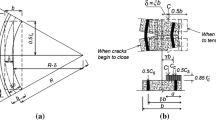Abstract
This paper describes the blind prediction carried out to simulate the response of a thin reinforced concrete wall tested under uni-directional (in-plane) quasi-static reverse cyclic loading. The specimen was a singly reinforced T-shaped wall panel with a shear-span ratio of 3.7. The response of the test specimen was simulated prior to the release of test results using a finite element model which had already been verified for its capabilities in capturing different failure patterns of rectangular walls, particularly out-of-plane instability. The numerical model predicted a flexural dominated response for the specimen accompanied by considerable out-of-plane deformations. The blind prediction report, submitted in advance to the principal investigator of the experimental campaign, included lateral load-top displacement response of the specimen, maximum out-of-plane deformation corresponding to each drift level, evolution of out-of-plane displacements throughout in-plane loading, response of the longitudinal reinforcement at the section exhibiting the maximum out-of-plane deformation, and von Mises as well as reinforcement stress distribution at some key points of the wall response. Furthermore, a parametric study was carried out addressing the effects of shear-span ratio, reinforcement eccentricity and axial load ratio on the wall response. Results of the numerical simulation that had been included in the blind prediction report have been compared with the experimental measurements indicating that the evolution of the out-of-plane deformation was well captured by the model.









































Similar content being viewed by others
References
Almeida J, Prodan O, Rosso A, Beyer K (2017) Tests on thin reinforced concrete walls subjected to in-plane and out-of-plane cyclic loading. Earthq Spectra 33:323–345
Bažant ZP, Oh BH (1983) Crack band theory for fracture of concrete. Matériaux et construction 16:155–177
Bazant ZP, Planas J (1997) Fracture and size effect in concrete and other quasibrittle materials, vol 16. CRC Press, Boca Raton
Beattie GJ (2004) Design of slender precast concrete wall panels—experimental testing. BRANZ Ltd, Judgeford, New Zealand, BRANZ Study Report SR 129
Chai YH, Elayer DT (1999) Lateral stability of reinforced concrete columns under axial reversed cyclic tension and compression. ACI Struct J 96:780–789
Dashti F, Dhakal RP, Pampanin S (2014) Blind prediction of a thin RC wall (TW1) tested in École Polytechnique Fédérale de Lausanne. Personal Communication, University of Canterbury
Dashti F, Dhakal R, Pampanin S (2015) Development of out-of-plane instability in rectangular RC structural walls. In: 2015 NZSEE conference, Rotorua, New Zealand. New Zealand Society for Earthquake Engineering
Dashti F (2017) Out-of-plane instability of rectangular reinforced concrete walls under in-plane loading, PhD thesis, Department of Civil and Natural Resources Engineering, University of Canterbury
Dashti F, Dhakal RP, Pampanin S (2017a) Numerical modeling of rectangular reinforced concrete structural walls. J Struct Eng. doi:10.1061/(ASCE)ST.1943-541X.0001729
Dashti F, Dhakal RP, Pampanin S (2017b) Validation of a numerical model for prediction of out-of-plane instability in ductile structural walls under concentric in-plane cyclic loading. J Struct Eng (under review)
De Borst R (1997) Some recent developments in computational modelling of concrete fracture. Int J Fract 86:5–36
DIANA T (2011) Finite element analysis user’s manual—release 9.4.4, 9.4.4 edn. TNO DIANA
Filippou FC, Bertero VV, Popov EP (1983) Effects of bond deterioration on hysteretic behavior of reinforced concrete joints, vol 13. Earthquake Engineering Research Center, University of California, pp 137–147
Goodsir WJ (1985) The design of coupled frame-wall structures for seismic actions. University of Canterbury
Johnson B (2010) Anchorage detailing effects on lateral deformation components of R/C shear walls. Master Thesis, University of Minnesota
Krolicki J, Maffei J, Calvi G (2011) Shear strength of reinforced concrete walls subjected to cyclic loading. J Earthq Eng 15:30–71
Mander J, Priestley MN, Park R (1988) Theoretical stress-strain model for confined concrete. J Struct Eng 114:1804–1826
Menegotto M, Pinto P (1973) Method of analysis for cyclically loaded reinforced concrete plane frames including changes in geometry and non-elastic behavior of elements under combined normal force and bending. In: IABSE symposium on the resistance and ultimate deformability of structures acted on by well-defined repeated loads, Lisbon. Association Internationale des Ponts et Charpentes
Mindlin RD (1951) Influence of rotary inertia and shear on flexural motions of isotropic, elastic plates. J Appl Mech 18:31–38
Moyer MJ, Kowalsky MJ (2003) Influence of tension strain on buckling of reinforcement in concrete columns. ACI Struct J 100(1):75–85
Oesterle R (1979) Earthquake resistant structural walls: tests of isolated walls: phase II. Construction Technology Laboratories, Portland Cement Association
Paulay T, Priestley M (1993) Stability of ductile structural walls. ACI Struct J 90:385–392
Reissner E (1945) The effect of transverse shear deformation on the bending of elastic plates. J Appl Mech 12:69–77
Rosso A, Almeida JP, Beyer K (2014) Short report on the experimental cyclic test of a thin RC wall (TW1) for blind prediction purposes. École Polytechnique Fédérale de Lausanne
Rosso A, Almeida J, Beyer K (2015) Stability of thin reinforced concrete walls under cyclic loads: state-of-the-art and new experimental findings. Bull Earthq Eng. doi:10.1007/s10518-015-9827-x
Thomsen JH IV, Wallace JW (2004) Displacement-based design of slender reinforced concrete structural walls-experimental verification. J Struct Eng 130:618–630
Vallenas JM, Bertero VV, Popov EP (1979) Hysteretic behaviour of reinforced concrete structural walls. Earthquake Engineering Research Center, University of California, Berkeley
Vecchio FJ, Collins MP (1986) The modified compression-field theory for reinforced concrete elements subjected to shear. ACI J Proc 83:219–231
Acknowledgements
The authors wish to acknowledge Prof. Katrin Bayer and her research team at EPFL (João P. Almeida and Angelica Rosso) for providing the input data of their experimental tests and facilitating the predictions. Also, the financial support provided by the Ministry of Business, Innovation and Employment (MBIE), SAFER concrete project and the Quake Centre at University of Canterbury to conduct this research is greatly acknowledged.
Author information
Authors and Affiliations
Corresponding author
Rights and permissions
About this article
Cite this article
Dashti, F., Dhakal, R.P. & Pampanin, S. Blind prediction of in-plane and out-of-plane responses for a thin singly reinforced concrete flanged wall specimen. Bull Earthquake Eng 16, 427–458 (2018). https://doi.org/10.1007/s10518-017-0211-x
Received:
Accepted:
Published:
Issue Date:
DOI: https://doi.org/10.1007/s10518-017-0211-x




